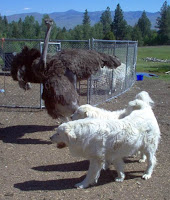The Polish Tatra Sheepdog is a very old, and very large breed of livestock guarding dog. They are also quite rare outside of Poland. In the United States there are between 200-300 total dogs. The breed is also known as Owczarek Podhalanski, Polish Mountain Sheepdog, Tatrahund, and Polish Shepherd. It is recognized by the UKC and FCI, but not the AKC.
The Polish Tatra Sheepdog is a large, white breed with a thick
double coat. Males stand up to 28" tall, with the females growing slightly smaller. They can weigh up to 130lbs. Polish Tatra Sheepdogs are intelligent, independent, and territorial. For hundreds of years it has been their job to guard over their flocks and families. They are mostly likely related to the
Kuvasz, a similarly large, white, Hungarian livestock guarding breed.
Like the Kuvasz and several other large, European breeds, the Polish Tatra Sheepdog can trace its origin to both the Mollaser dogs of the Balkins, as well as from Central Asian Mastiffs. The Tatra Mountains were first colonized in the
14th century, and the dogs used by the farmers then, and for centuries after, would be the ancestors of the modern breed. The breed nearly became extinct after
World War II, when the numbers of herdsman and flocks declined. In the 1960s, efforts were taken to save and revitalize the breed. There are now about 3,000 individuals worldwide, and they are still being used in their original
livestock guarding roles.
Thanks Michelle for the suggestion!


Comments
Post a Comment